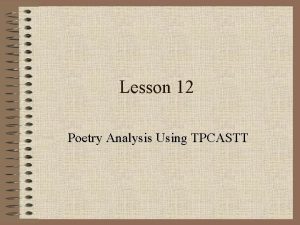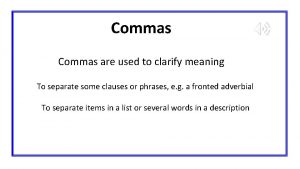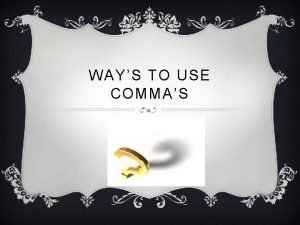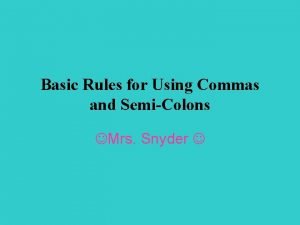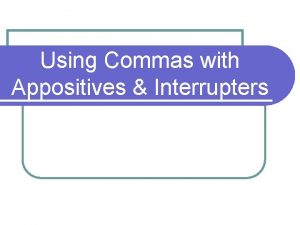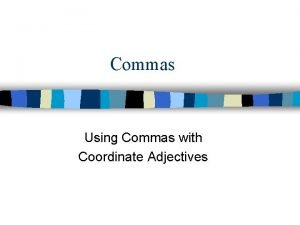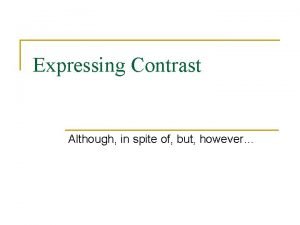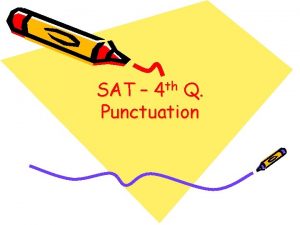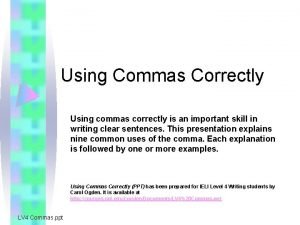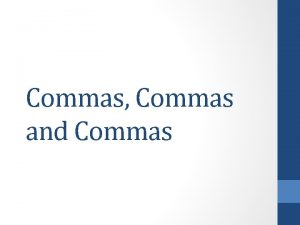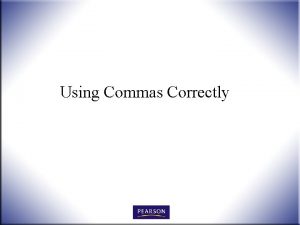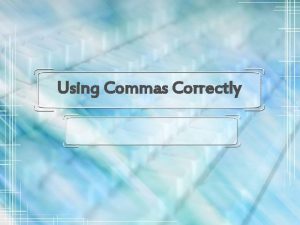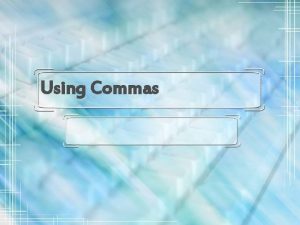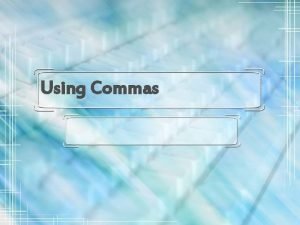Todays Agenda Daily Starter Using Commas Correctly Commas










- Slides: 10

Today’s Agenda • Daily Starter • Using Commas Correctly • Commas with Transitional Terms • Commas with Adverb Clauses • Homework • Quiz Corrections: on a separate sheet of paper, correct each mistake. Explain why each is correct. • Commas with Adverb Clauses: Write a paragraph describing the career/major you are interested in and why it interests you. In a second paragraph, imagine what you might be doing in that field ten years from now. Try to use as many adverb clauses as possible, punctuating them as discussed today.

Daily Starter • Write a super sentence using each of the FANBOYS! • Place your commas accordingly.

Commas with Transitional Terms Essential Vocabulary • Transitional terms: Sometimes called conjunctive adverbs. Includes words such as futhermore and however. • Comma splice: The use of just a comma to separate two independent clauses. (Hello run-on sentence!) • Transitional terms can lead to two types of punctuation errors: • Comma splice • Missing comma

Identifying Transitional Terms • Transitional Term Movement Tip: A transitional term can be moved around in a sentence (or even deleted). Move only the term you are testing – not anything else. Ex: Tip: The Hope diamond is the best known diamond, however, the Cullinan diamond was larger before it was cut, however. in addition for example on the other hand as a result again for instance however accordingly also in fact instead consequently besides in particular nevertheless subsequently further(more) namely nonetheless therefore likewise specifically on the contrary thus moreover otherwise similarly still

Commas with Transitional Terms • Once you find a transitional term in your writing, first make sure you do not create a comma splice (run-on) in using it. Use a semicolon before the term if it joins two independent clauses. • The Hope diamond is the best-known diamond; however, the Cullinan diamond was larger before it was cut. • If the transitional term does not separate two independent clauses, simply use a comma after the transitional term. • For instance, they used a powder made from the ashes of burnt ox hooves. • If the transitional term is in the middle of a sentence and does not separate two independent clauses, a comma should come before and after the term. • They used, for instance, a powder made from the ashes of burnt ox hooves.

Let’s Practice! Underline the transitional terms in the following sentences, and punctuate each sentence correctly. Confirm your answer by moving the transitional term to another position in the sentence. If there are no errors, write OK after it. 1. Bill said he might be late; indeed, he was four hours late. 2. Little is known about the Pilgrim ship Mayflower; we do know however that it weighed about 180 tons. 3. English is the predominant language in the United States, nevertheless, over three hundred languages are spoken within the US borders. 4. The oldest known weapon is a broken spear found in Great Britain; it is estimated to have been made around 200, 000 B. C. 5. A serious accident has caused major delays. In fact some commuters have decided to stay home.

Commas with Adverb Clauses Essential Vocabulary • Adverb clause: a group of words that answers the question when, where, why, how, or to what degree about the verb in the sentence. (Type of dependent clause!)

Identifying Adverb Clauses • Adverb Clause Movement Tip: An adverb clause is the only type of dependent clause that can be moved around in a sentence. • If Steven is ready, we can leave. Cause Condition Contrast Place Time As As if Although Where After Because Assuming that Even though Wherever As soon as Since If Though So that In case Since Unless Until When Whether Whenever Before

Let’s Practice! 1. When I visit my parents in New Mexico I always bring 2. 3. 4. 5. them something from my part of the country. I will go with you, after I finish eating. After Omar competed in the third basketball tournament of the season he was not eager to travel again. Because the test included over a hundred questions I could not finish it in just fifteen minutes. Stephanie wants to leave, because she smells a strange odor in the room.

Homework • Write a paragraph describing the career/major you are interested in and why it interests you. In a second paragraph, imagine what you might be doing in that field ten years from now. Try to use as many adverb clauses as possible, punctuating them as discussed today.
 Todays agenda
Todays agenda Which sentence uses commas correctly the former astronaut
Which sentence uses commas correctly the former astronaut When to use a comma before and
When to use a comma before and Agenda sistemica y agenda institucional
Agenda sistemica y agenda institucional Using commas to separate clauses
Using commas to separate clauses Awubbis
Awubbis Comma before or after however
Comma before or after however Interrupters commas
Interrupters commas Coordinate adjectives comma
Coordinate adjectives comma However nevertheless although in spite of
However nevertheless although in spite of However punctuation
However punctuation
